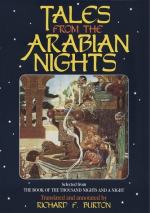[FN#333] Arab. “Tamer al-Hindi"=the “Indian-date,” whence our word “Tamarind.” A sherbet of the pods, being slightly laxative, is much drunk during the great heats; and the dried fruit, made into small round cakes, is sold in the bazars. The traveller is advised not to sleep under the tamarind’s shade, which is infamous for causing ague and fever. In Sind I derided the “native nonsense,” passed the night under an “Indian date-tree” and awoke with a fine specimen of ague which lasted me a week.
[FN#334] Moslems are not agreed upon the length of the Day of Doom when all created things, marshalled by the angels, await final judgment; the different periods named are 40 years, 70, 300 and 50,000. Yet the trial itself will last no longer than while one may milk an ewe, or than “the space between two milkings of a she-camel.” This is bringing down Heaven to Earth with a witness; but, after all, the Heaven of all faiths, including “Spiritualism,” the latest development, is only an earth more or less glorified even as the Deity is humanity more or less perfected.
[FN#335] Arab. “Al-Kamarani,” lit. “the two moons.” Arab rhetoric prefers it to “Shamsani,” or {`two suns,” because lighter (akhaff), to pronounce. So, albeit Omar was less worthy than Abu-Bakr the two are called “Al-Omarani,” in vulgar parlance, Omarayn.
[FN#336] Alluding to the angels who appeared to the Sodomites in the shape of beautiful youths (Koran xi.).
[FN#337] Koran xxxiii. 38.
[FN#338] “Niktu-hu taklidan” i.e. not the real thing (with a woman). It may also mean “by his incitement of me.” All this scene is written in the worst form of Persian-Egyptian blackguardism, and forms a curious anthropological study. The “black joke” of the true and modest wife is inimitable.
[FN#339] Arab. “Jamiz” (in Egypt “Jammayz”) = the fruit of the true sycomore (F. Sycomorus) a magnificent tree which produces a small tasteless fig, eaten by the poorer classes in Egypt and by monkeys. The “Tin” or real fig here is the woman’s parts; the “mulberry- fig,” the anus. Martial (i. 65) makes the following distinction:—
Dicemus
ficus, quas scimus in arbore nasci,
Dicemus
ficos, Caeciliane, tuos.
And Modern Italian preserves a difference between fico and fica.
[FN#340] Arab. “Ghaniyat Azara” (plur. of Azra = virgin): the former is properly a woman who despises ornaments and relies on “beauty unadorned” (i.e. in bed).
[FN#341] “Nihil usitatius apud monachos, cardinales, sacrificulos,” says Johannes de la Casa Beneventius Episcopus, quoted by Burton Anat. of Mel. lib. iii. Sect. 2; and the famous epitaph on the Jesuit,
Ci-git
un Jesuite:
Passant,
serre les fesses et passe vite!
[FN#342] Arab. “Kiblah"=the fronting-place of prayer, Meccah for Moslems, Jerusalem for Jews and early Christians. See Pilgrimage (ii. 321) for the Moslem change from Jerusalem to Meccah and ibid. (ii. 213) for the way in which the direction was shown.




